TOURISM IN M'MUOCK
M’muock Fosimondi is located in Alou Subdivision at the center of Lebialem Division in the South West Region of Cameroon in Central Africa. This area sits within the Bamboutous Caldera, which is located about 250km north east of Mount Cameroon along the Cameroon Volcanic Line. Undoubtedly, M’muock Fosimondi is one of the most touristic sites of the Lebialem Division of the South West Region, Cameroon with both tropical and savanna or sahelelian climate and vegetation. Based on this fact, it has been considered by many as “Cameroon in miniature”.
According to Dr. Fozao Kennedy, a Senior Lecturer in the Department of Geology, University of Buea, “M’muock Fosimondi from the upper part (Meleta-h) to the lower part (Lekohoquai) and from the west (Mesongho) to the east (Toh Tsokeang), you see a summary of Cameroon in it.”
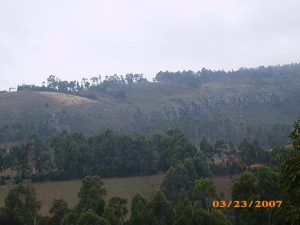
THE LOWER (TROPICAL) PART OF M’MUOCK FOSIMONDI
The lower part of the kingdom starting from Mbei Nteuh crossing to Bekoh, moving through Lekohoquai down to its boundary with Folepi and Bechati, we find mostly dense tropical evergreen forest. This area has a famous forest reserves (Mbei-Ntou) which are the homes of some rare species of fauna and flora that cannot be found anywhere in the world, e.g. the cross river gorillas, chimpanzees, tigers, antelopes, monkeys, pangolins, porcupines, kites, owls, torrako, etc., rare species of birds such as “Ngwuoh”, and rare species of trees both medicinal and non medicinal including red wood, iroko, mahogany, sapele, white wood, iron wood and others. All these are found in some beautiful forests in the southern region of Cameroon where the pygmy community dwell. No one is allowed to clear, farm, fell or carry out any illegal activity in the Mbei-Ntou forest. This forest has been preserved over centuries and constitute one of the kingdom assets. National and international researches on wildlife have been conducted in this forest. Other forests in this area are not reserved. These include Mbei-Telang and Mbei-Lekohoquai.
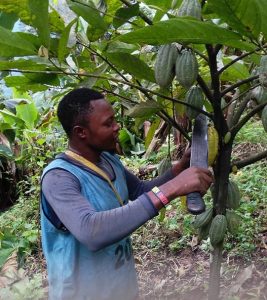
These forests are very rich in biodiversity and are also used for farming. Mbei-Ntou and Bekoh have lakes. The biodiversity of these forests has been very beneficial to the M’muock people including food, drugs and medicine, ecological benefits, touristic, Aesthetic, hunting, habitat preservation, preservation of wildlife and cultural benefits. Because of the tropical nature of the lower part of the kingdom, the climate there is tropical and vegetation is evergreen liking it to the climate in the southern part of Cameroon.
Here, cocoyams, plantains, oil palm, bananas, colocasia, raffia palms, cassava, groundnuts, cocoa, coffee and kola nuts are cultivated. Here also, there is a popular mountain range called “Lekoh Ntoh”.
THE CENTRAL (SEMI TROPICAL) PART OF M’MUOCK FOSIMONDI
In the central part of M’muock Fosimondi Kingdom that extend from Molah Palace upward to Mbuobeka range, that move eastward to Awut involving Totsonkeang and westward to Mengai, Achienlekot and Mesongho, you can see the transition from the thick tropical forest to the grass fields. Mbuobeka range is more than 2000 meters above sea level and causes the central part of the village (Awut, Membei and Chilembah) to be constantly moist and foggy, imposing a higher humidity and rainfall.
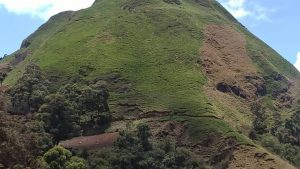
Still in the central part of M’muock Fosimondi, you find beautiful hilly, mountainous undulating topography with very fertile and nourishing soils. Such prominent mountains and hills include Lekot Lihle, Lekot Mengai, Lekot Njingmbah and the famous Totsonkeang that separate M’muock Fosimondi from Mockmbie. Since the area has both the mix climate of savanna and tropical, mixture of both savanna and tropical crops are cultivated there including cocoyams, plantains, bananas, Irish Potatoes, cabbages, carrots, green beans, green spices, onions, leeks garlic, and tomatoes.
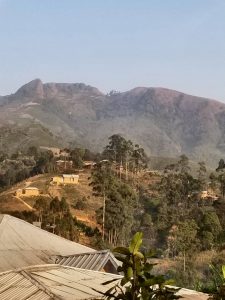
These area also has many important features like the popular caves of bats found in Ntsang quarter called Mbouhbetou, the caves are very prominent and have been a permanent dwelling place for bats over centuries.
THE UPPER (SAVANNA) PART OF M’MUOCK FOSIMONDI
The upper part that extends from Ntsombuobeka through Mbelenka right up to Mount Meleta-h with its sahelelian vegetation which purely resembles the northern part of Cameroon. Here, the climate is just like that of the West and North West Regions of Cameroon. In other words, according to Mr. Kwenchia Aloys, a M’muock historian and a teacher “the upper part of the kingdom is more of savanna and extends as a plateau while the lower part is forest. This confers on the kingdom a typical picture of Cameroon in miniature. The grassland area with its slopes and elevations gives a picture of Switzerland in Cameroon.”
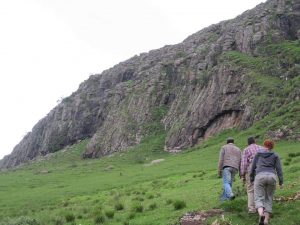
The northern part of the kingdom is particularly noted for fertility and good for rearing of cows, goats and sheeps and also cultivation of food crops such as Irish Potatoes, cabbages, carrots, green beans, tomatoes, onions, leeks, garlic, etc.
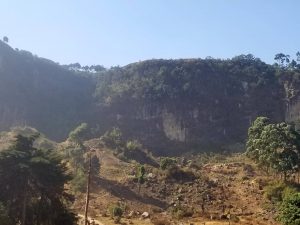
In the northern part of M’muock, there is Mbelenka range that extends right to Njingmbah and goes right to Mengai. This range forms the south western flank of the Bamboutous Caldera, a prominent caldera in the Cameroon Volcanic Line. This range helps to keep the Mbelenka – Njingellah and Atsolah area humid for agriculture. At the foot of the Mbelenka range are caves as you move towards Befombei on your way to Awut. These caves served as refuge during wars in the past but now serve as the habitat for animals.
Sources
- BENOH M’MUOCK (M’muock News) MAGAZINE, 2nd Edition (2008).
- Mr Kwenchia Aloys (2018), Discovering the People of M’muock (Fosimondi)